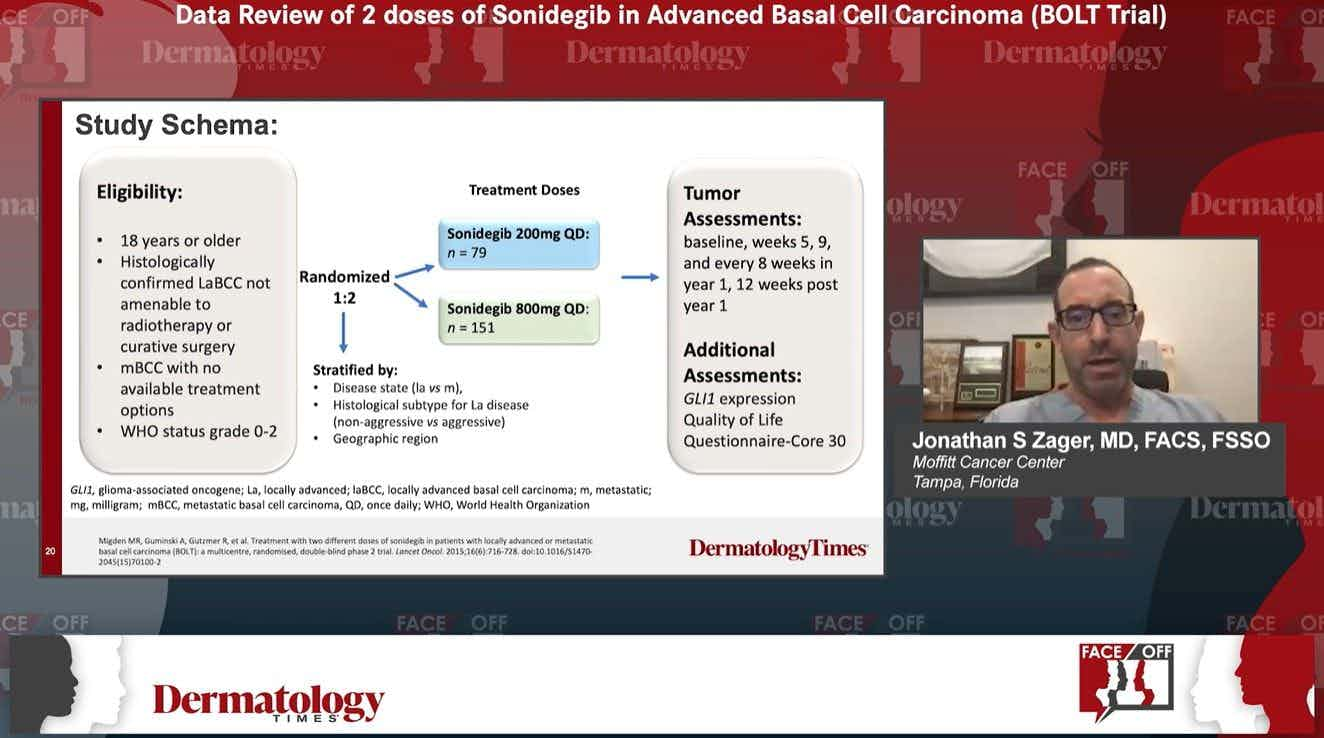- Acne
- Actinic Keratosis
- Aesthetics
- Alopecia
- Atopic Dermatitis
- Buy-and-Bill
- COVID-19
- Case-Based Roundtable
- Chronic Hand Eczema
- Chronic Spontaneous Urticaria
- Drug Watch
- Eczema
- General Dermatology
- Hidradenitis Suppurativa
- Melasma
- NP and PA
- Pediatric Dermatology
- Pigmentary Disorders
- Practice Management
- Precision Medicine and Biologics
- Prurigo Nodularis
- Psoriasis
- Psoriatic Arthritis
- Rare Disease
- Rosacea
- Skin Cancer
- Vitiligo
- Wound Care
News
Article
Deep Histological Margins Do Not Increase cSCC Recurrence Risk if Tumor is Fully Excised
Author(s):
Margins < 1 mm also do not increase the risk of cutaneous squamous cell carcinoma recurrence risk if the galea aponeurotica is not involved.
Patients with cutaneous squamous cell carcinoma (cSCC) exhibiting histological margins < 1 mm are not at a greater risk of recurrence, so long as the tumor has been fully excised and there is no galea aponeurotica involvement, according to a study published in the Journal of the European Academy of Dermatology and Venereology.1
Researchers also noted that in cases of cSCC of the scalp, surgical excision should include galea to allow for a comprehensive, adequate assessment of deep margins.
Background and Methods
Wide local excision of cSCC has a high 5-year disease-free survival rate (≥91%) and a low overall recurrence rate of 0% to 14%.2
In 2021, the British Association of Dermatologists established the current guidelines for excision, which includes recommendations for a peripheral margin of 4 to 10mm.3 However, authors of the present study, Verdaguer-Faja et al, note that these recommendations lack advice for histological margins, particularly for tumors on the scalp.
To address this gap, researchers investigated whether cSCC tumors with close deep histological margins (< 1 mm) are more likely to recur compared to those with wider margins (≥ 1 mm), while also comparing peripheral margins and assessing the effect of concurrent invasion of the galea aponeurotica.
The multicenter, retrospective cohort study was conducted across 10 Spanish hospitals and examined cases of primary cSCC of the scalp between 2016 and 2021. Data focused on tumors excised with a minimum 4 mm peripheral margin and including the galea aponeurotica. Researchers excluded cases of tumors with anatomical variations, non-evaluable margins, or those requiring additional surgery.
Findings
The study analyzed 338 cases of cSCC from 295 patients. Tumors were most commonly located on the parietal and frontoparietal regions of the scalp.
Researchers found that while the distance to deep margins varied, with 71 tumors having margins < 1 mm and 267 tumors having margins of ≥ 1 mm, the demographic and clinical characteristics were largely similar between these groups.
Furthermore, tumors with deep margins < 1 mm were more frequently associated with larger diameters, deeper invasions, and closer peripheral margins compared to those with deeper margins. Tumor staging demonstrated that tumors with narrower deep margins were more likely to be classified as having worse stages.
A higher percentage of these tumors were also treated with adjuvant radiotherapy, indicating potentially more aggressive management due to increased risk factors. Despite these observations, deep margins < 1 mm did not significantly correlate with increased recurrence risk when considered independently.
In contrast, close peripheral margins were strongly associated with a higher risk of recurrence. Specifically, tumors with peripheral margins < 1 mm had a substantially greater likelihood of recurrence. Other factors, including immunosuppression, large tumor diameter, and perineural invasion, were also linked to worse outcomes.
When analyzing the combined effect of deep margin status and invasion of the galea aponeurotica, tumors with both narrow deep margins and galeal invasion demonstrated a significantly higher recurrence risk.
Conclusions
Potential limitations of the study, noted by researchers, include its retrospective design, incomplete galea aponeurotica data, a small number of recurrences, and short length of follow up. In addition, the study focused exclusively on removal via wide local excision, not Mohs micrographic surgery.
According to researchers, this study is only estimated to be the third to analyze recurrence risk in cSCC tumors local to the scalp via deep margin status.
It is also the first known study to evaluate the recurrence risk in scalp cSCCs based on histological deep margin width, considering additional prognostic factors and mortality from other causes in an older patient demographic.
"We believe that tumours with involved and close deep margins should not be grouped together as far as their recurrence risk is different," according to Verdaguer-Faja et al. "Surgical excision of cSCCs of the scalp should include the galea to enable complete assessment of the excised tumour and avoid complications. These results may not be extrapolated to cSCCs from other locations, which do not share the particular anatomical characteristics of the scalp."
References
- Verdaguer-Faja J, Guerra-Amor Á, Ferrándiz-Pulido C, et al. Histological deep margins in cutaneous squamous cell carcinoma of the scalp and risk of recurrence. J Eur Acad Dermatol Venerol. July 22, 2024. https://doi.org/10.1111/jdv.20250
- Seretis K, Thomaidis V, Karpouzis A, Tamiolakis D, Tsamis I. Epidemiology of surgical treatment of nonmelanoma skin cancer of the head and neck in Greece. Dermatologic Surg. 2010; 36: 15–22.
- Keohane SG, Botting J, Budny PG, et al. British Association of Dermatologists guidelines for the management of people with cutaneous squamous cell carcinoma 2020. Br J Dermatol. 2021; 184: 401–414.
Newsletter
Like what you’re reading? Subscribe to Dermatology Times for weekly updates on therapies, innovations, and real-world practice tips.
















